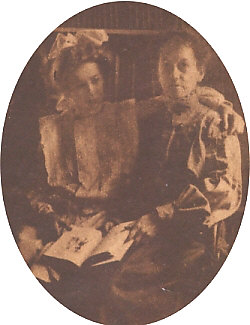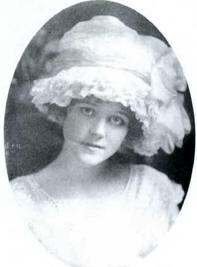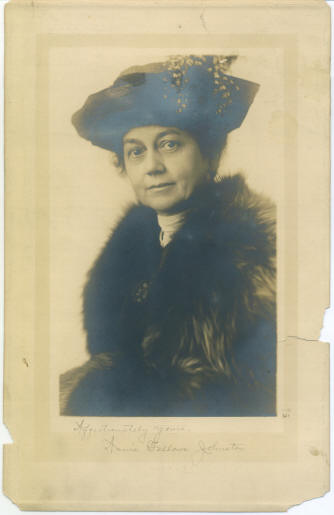Annie Fellows Johnston
a short biography
*May 15, 1863 Evansville, Indiana
+October 5, 1931 Pewee Valley, Kentucky
Daughter of Albion and Mary Erskine Fellows
Married to William L. Johnston, 1888-1892

[Left: Annie Fellows Johnston posed with Hattie Cochran, on whom the character for “The Little Colonel” and “The Little Colonel’s Holidays” were based. 1928]
Annie Fellows Johnston received tremendous fame and popularity around the turn of the 20th century as an author of books for children. She is best known for her thirteen book series beginning with The Little Colonel, although she wrote over forty books in all as well as contributed occasional stories to periodicals such as the Youth’s Companion.
The illustration shows Annie Fellows Johnston around 1928 with the then grown-up Hattie Cochran, the real-life Little Colonel. (from the The Sunday Herald Post, Louisville, Kentucky, December 23, 1928) Most of the characters in Mrs. Johnstons’ semi-biographical works were based on actual people, places and experiences. For the Little Colonel Series, Johnston fictionalized Pewee Valley, Kentucky, just outside Louisville, as Lloydsborough Valley.
Her Early Life

[Left: Portrait of a young Annie Fellows Johnston By Kate Matthews,Private collection
Pewee Valley]
Born Annie Julia Fellows, Annie grew up with her mother, brother Erwin and two sisters, Lura & Albion, on a farm in McCutchanville, Indiana, near Evansville. Her father, Albion, a Methodist minister, died when she was only two, but left his influences through his theological books. Annie began writing already as a girl, producing poems and stories imitating those she read in Godsey’s Lady’s Book, Youth’s Companion and St. Nicholas. She was also known to have read every book in her Sunday school library. She attended district school, and even taught a year when she was 17. Her mother was a firm believer in education for women.
Annie attended the University of Iowa for one year (1881-82), then returned to Evansville to teach for three years, and later to work as a private secretary. She traveled for several months through New England and Europe, staying with cousins along the way. The influence of these trips would be seen later in many of her her works. When she returned, she married William L. Johnston (a cousin and a widower with three young children.) He encouraged her to write, and she began contributing stories to periodicals. William died in 1892, leaving Annie a widow with his children to support (she never had any of her own). It was at that time that Annie began her career as a writer.
Her Career:
Mrs. Johnston’s first book, Big Brother, was published in 1893, followed by Joel: A Boy of Galilee in 1895. In 1895, Annie visited Pewee Valley, Kentucky, where her stepchildren were staying with relatives. She so fell in love with the area, with its atmosphere of leisure and aristocracy left over from the days of slavery, that she would eventually return to make it her permanent home. It was then that she also met the little Hattie Cochran, a feisty and stubborn little girl whose spirit and demeanor resembled that of an old-time colonel.
Annie returned to Evansville and wrote The Little Colonel in 1895, and it quickly became a success. Twelve more volumes of the Little Colonel series would appear over the next thirty years, the first ones being The Giant Scissors (1898) Two Little Knights of Kentucky (1899), The Little Colonel’s House Party (1900), The Little Colonel’s Holiday (1901), The Little Colonel’s Hero (1902) and The Little Colonel at Boarding School (1904).
Johnston moved to Pewee Valley in 1898. In 1899, her step-daughter Rena, died, and her step-son John’s health deteriorated so that in 1901 she took him West where the climate was more favorable; first in Arizona, then California and for eight years in Texas, until his death in 1910. During this time, Johnston wrote The Little Colonel in Arizona (1904), The Desert of Waiting (1905), The Little Colonel’s Chum: Mary Ware (1908), and Mary Ware in Texas (1910), all set in the Southwest. During this time she also wrote The Little Colonel’s Christmas Vacation (1905), The Little Colonel: Maid of Honor (1906), Legend of the Bleeding Heart (1907) and the Little Colonel’s Knight Comes Riding (1907)
In 1910, Annie Fellows Johnston returned to Pewee Valley and lived there until her death in 1931. Her best known books of this period were Mary Ware’s Promised Land (1912), Miss Santa Clause of the Pullman (1913), Georgina of the Rainbows (1916), It was the Road to Jericho (1919), The Land of the Little Colonel: Reminiscence and Autobiography (1929). In 1935, Twentieth Century Fox released “The Little Colonel,” a film directed by David Butler, with Shirley Temple playing the part of the Little Colonel, a role well suited to her. Lionel Barrymore played the part of the Old Colonel.
Follow this link for a Complete Listing of Annie Fellows Johnston’s Works.
Follow this link to read a collection of Letters from Annie Fellows Johnston
**************
As you browse through this site, you will find more biographical information on nearly every page, whether it be the people and places she knew and wrote about, or her own thoughts as reflected in her letters and writings.

Louise Lawton’s (“Elise Walton’s”) copy of
a portrait of Annie Fellows Johnston, possibly her mother’s
before that from the Lawton family private collection